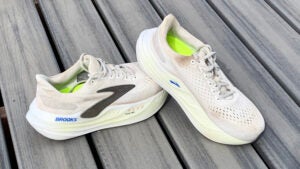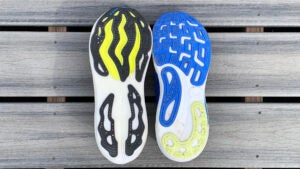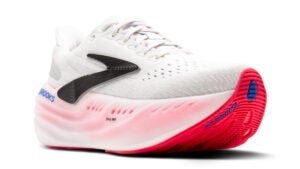New perk: Easily find new routes and hidden gems, upcoming running events, and more near you. Your weekly Local Running Newsletter has everything you need to lace up! Subscribe today.
Maximalism is all the rage today. Running shoes from every brand get taller each year. But I was still surprised to see a shoe this high and this soft from Brooks.
Brooks is known for making shoes that are stable, grounded, and supportive. Even their super shoe, the Hyperion Elite 4, scored the firmest marks of all carbon-plated marathon racers in the Outside Lab and delivers a quick, responsive roll, rather than the trampoline-like squish and rebound of most other carbon-fiber racers. However, the new Glycerin Max—which stands alongside the Glycerin on the luxury end of the comfort spectrum—has a decadently soft, maxed-out midsole. If you run in it, however, and pay attention, you’ll notice it is still stable and supportive under the plushness.
A decade ago, this shoe couldn’t be built, says Carson Caprara, senior vice president of footwear at Brooks. The foams available at the time were too heavy, they didn’t move naturally with the forces of the stride, and they were squishily unpredictable when soft, causing joints to stiffen and increasing impact forces rather than reducing them.
But the world has changed, and the technology and design understanding now exists for Brooks to make a max-height shoe that is also light, responsive, and balanced. “We try to always have balance in our ride,” Caprara says.
It didn’t hurt that Caprara started running in one of the early prototypes of the maxed-out model and found it worked magic on his ailing knees. Plus their lab reported that the prototype was delivering, Caprara says, “Some of the best scores we’ve ever received in terms of perception and biomechanics for a certain group of people.” They were so excited they rushed the production up six months, with the launching in October 2024.
What’s unique about the Glycerin Max is that it is softer on the outside and firmer on the inside—a little bit firmer in the heel, a lot in the forefoot—within the same slab of foam. New technology allows Brooks to tune the properties of different sections of a foam midsole during its manufacture. Caprara says that they inject two different chemistries into the midsole mold before the supercritical gas-infusion process. “Then when it hits the high-pressure nitrogen infusion, the two cell structures act differently,” he explains, “The inner cell structures stay pretty small and tight and the outer structures blow up a little bit more and create more softness and forgiveness. It’s done without seams and ridges. And so, therefore, it just feels more consistent throughout.”
The result is a high-cushion shoe that I found doesn’t wallow and allows the foot to engage as it rolls through the stride, making it a shoe that I, usually a max-shoe hater, wanted to wear more.
If you buy through our links, we may earn an affiliate commission. This supports our mission to get more people active and outside. Learn more.

Brooks Glycerin Max
Price: $200
Weight: 10.5 oz (men’s), 9.5 oz (women’s)
Stack Heights: 45.25mm (heel), 39.25mm (forefoot)
Heel-to-toe Drop: 6mm
Shop Men’s at Brooks Shop Women’s at Brooks
At a Glance
Pros
- Soft, cushioned feel on landings
- Stable, responsive stance and push-off
- Smooth-rolling transition heel-to-toe
Cons
- Hard to turnover quickly
- Somewhat heavy
What’s New:
- The Glycerin Max is the tallest shoe ever built by Brooks, with a whopping 45.25 millimeters under the heel and 39.25 under the forefoot (making it illegal for racing as it exceeds World Athletics’ maximum stack height of 40 millimeters).
- The sole is the widest on any Brooks shoe ever and has raised sidewalls from heel to toe cradling the foot on both sides.
- The nitrogen-infused EVA-based midsole is tuned during expansion to have more soft and plush foam in the heel and more firm and responsive foam in the forefoot.
- A steep, late-stage rocker rolls the foot off the toe after a brief stable stance.
Brooks Glycerin Max: First Impressions
I’ve run in the Glycerin Max for 10 days, mostly for easy daily runs, plus during a medium-long run and a speed workout where I started with 800-meter repeats at marathon pace and gradually progressed to 200-meter sprints.
I’m generally not a fan of high-stack, high-cushioned shoes, but I found the Glycerin Max coddled me without feeling like I was running in loose sand or fighting to stay balanced. The ride was smooth and easy, even luring me into a few extra miles on a few recovery days.
I’ve been surprised by two max-cushioned shoes lately: the New Balance Balos, and this one. The Balos works for me by being so soft that I find the ground at the bottom for balance and push-off. The Glycerin Max works by acting like an alternative ground that my feet can interact with. Caprara says, “You can create like a bathtub effect and the foot actually moves naturally within it.” The Glycerin Max does this smoother and more comfortably than any max shoe I’ve tried before.
The Glycerin Max’s midsole strategy doesn’t appear new on first glance: many other shoes have used a frame and inner core that have different properties, and several models have had a softer heel and firmer forefoot. But in the past, the frame has almost always been made of the firmer foam, providing a more rigid cradle for a softer insert. And, dual-density midsoles have always had a dividing line, creating discontinuity during the heel-toe transition.

The Glycerin Max has the softer, larger-cell material on the outside, where it cushions and collapses on impact, letting my foot roll gradually onto the extra-wide platform that keeps it from being at all tippy. The shoe starts feeling more stable as I roll smoothly onto the midfoot and to the toe, without the “up and over” effect of some max-cushioned models. Caprara explains that they tune about 50 percent of the heel foam to be smaller-cell, and add more of the responsive tuning as they move forward until it makes up nearly 100 percent of the forefoot. “This makes sure that when your foot is looking for a bit more proprioception, a bit more response getting out of that landing, that it’s activating right away,” he says.
I appreciate this transition, but, for me, the ride really shines when I roll onto the toe. I feel perfectly placed support just behind the ball of the foot immediately before my met heads sink into a thick, responsive platform that quickly falls away to the rockered toe-off. I’m well protected from any ground forces, but don’t feel wobbly or wallowing.
Caprara says they obsess over creating this ride. “Where do we put the apex point on the shoe? Where’s the ground contact zone? Where do we perceive peak pressure to be?” they ask. “We put a lot of time and energy into how that shoe moves through the gait cycle to keep anybody who runs in it feeling very stable, even though you’re really high off the ground and you have a very soft material under your foot.”

As much as I enjoyed the sensation on easy runs, the ride got clunky as I dialed up to a tempo pace. The foam is too soft and responds too slowly to let me increase my cadence much (and even at an easy pace, my cadence was slower than normal in these shoes). Surprisingly, the shoe felt more at home when I got up on my toes to sprint, as I was landing and powering off the springy forefoot foam exclusively, with long, powerful strides. But the shoe is too heavy to want to wear it for much speed work.
Complementing the luxurious ride, the upper is plushly padded, flexible, and breathable. The fit is wide enough to accommodate Correct Toes without any discomfort, yet not at all sloppy, holding my foot securely on the wide platform (the full-length sidewalls help as well).
I’m still enough of a minimalist that on most days I prefer the ride of a firmer, thinner shoe that lets me feel more of the ground—like the Brooks Hyperion. But I appreciated how smoothly the Glycerin Max made easy miles go by and how it coddled my feet and lower legs—so much so that the shoe is the very rare max model to make my regular rotation shelf.
Brooks Glycerin Max: Who Is It For?
Runners who like soft landings but a springier transition and push-off—while still well-distanced from the ground—will love this shoe. Runners who prefer or need a rockered toe-off rather than a flexible forefoot will enjoy the Glycerin Max’s well-tuned roll. Runners who haven’t had luck with high-stack, highly cushioned shoes in the past may find the Glycerin Max works for them, particularly for recovery days.
Similar Shoes
While the Glycerin Max is unique, some non-plated shoes that are similarly max-height and not overly squishy are: Asics Super Blast 2, Hoka Skyflow, Puma Magnify Nitro 2, Altra Via Olympus 2
RELATED: Supershoe Evolved: On Cloudboom Strike First Run Review
